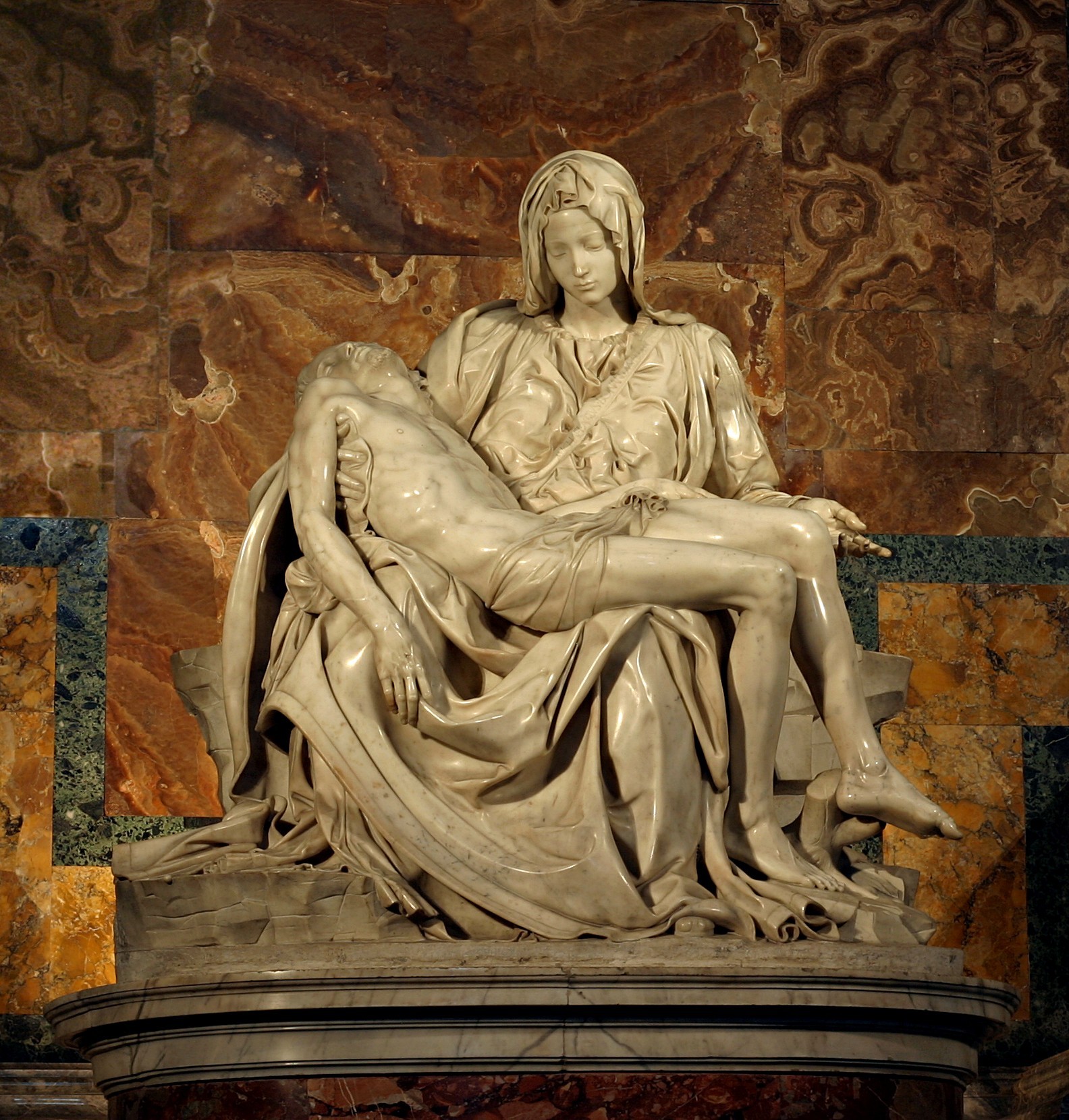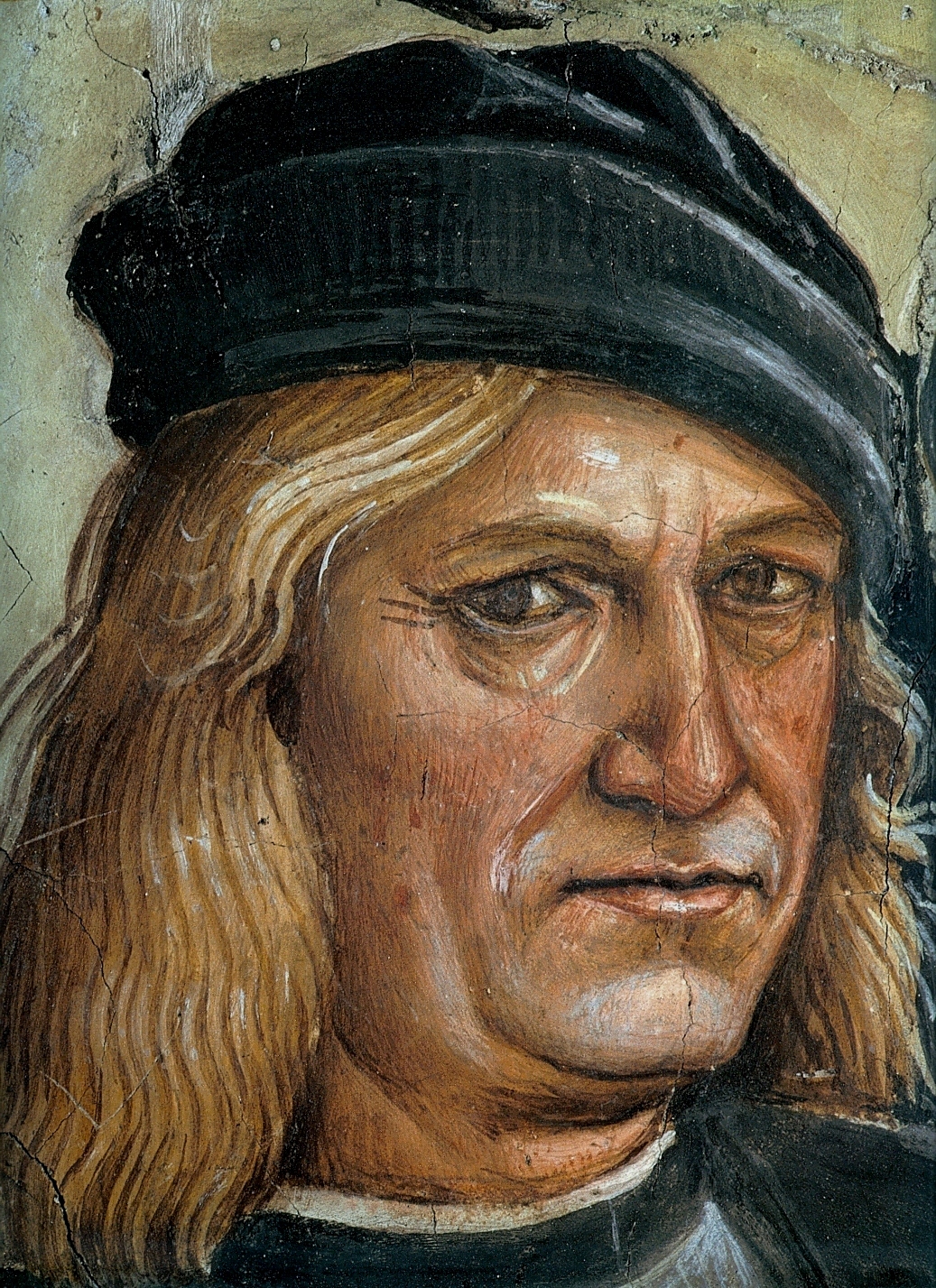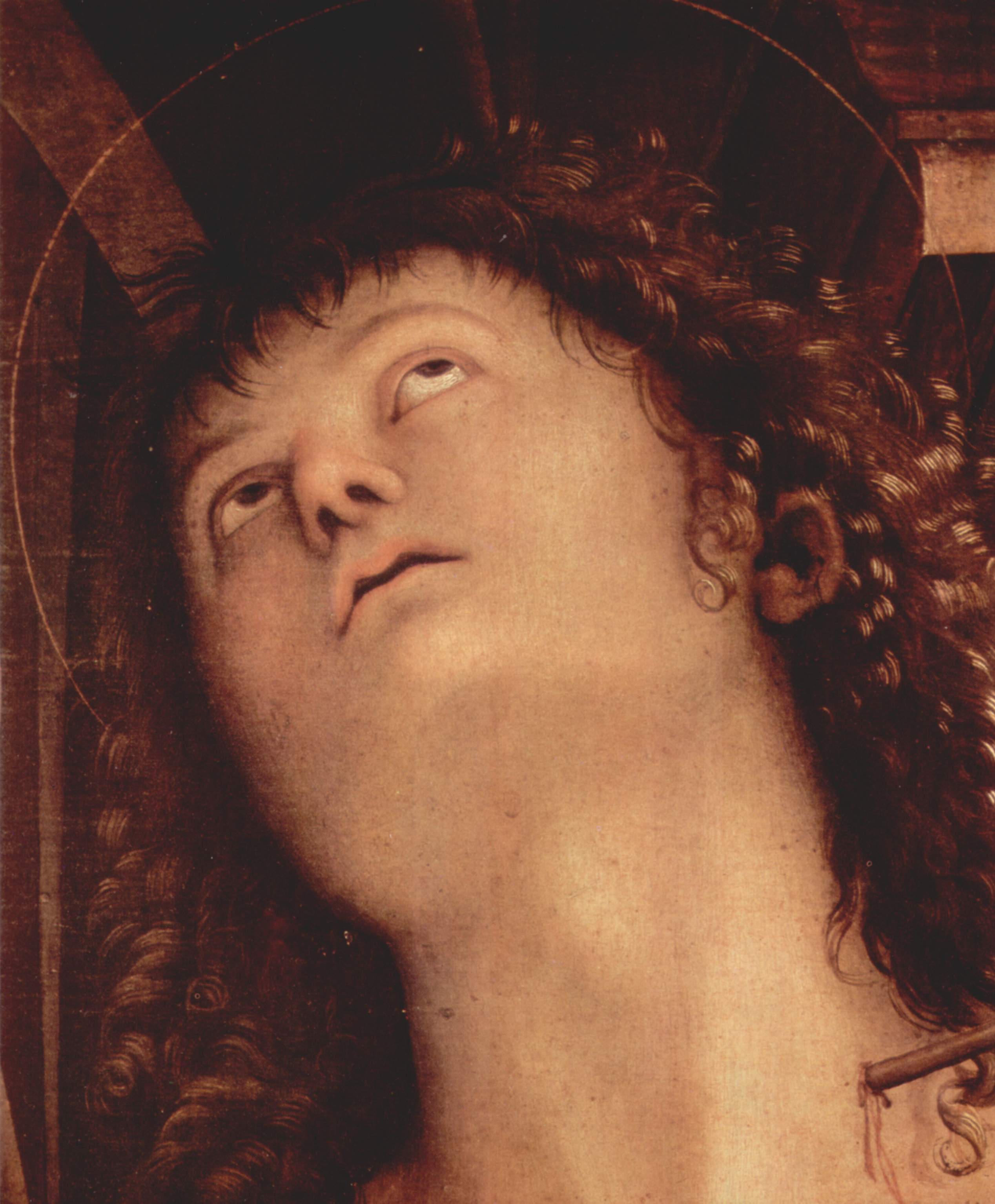|
Pietà (Perugino)
''Pietà'' is a painting by the Italian Renaissance artist Pietro Perugino, executed around 1483-1493, and housed in the Uffizi Gallery, Florence. History The work was painted for the church of the convent of San Giusto alle mura together with the ''Agony in the Garden'' and a ''Crucifixion''. Renaissance art biographer Giorgio Vasari saw them in side altars of the church of San Giovanni Battista alla Calza, after the original location had been destroyed during the Siege of Florence in 1529. It was moved to the Uffizi in the 20th century. The dating of the work is disputed: it varies from 1482, the year of Perugino's return from Rome, to a slightly later period, although before the end of the century, when the artist started to use only line oil, which in these works is used only at an experimental level. The painting was restored in 1998. Description The scene of the Pietà was depicted by Perugino under a portico, a typical theme of his art in the 1480s and 1490s (used ... [...More Info...] [...Related Items...] OR: [Wikipedia] [Google] [Baidu] |
Pietro Perugino
Pietro Perugino (, ; – 1523), born Pietro Vannucci, was an Italian Renaissance Painting, painter of the Umbrian school, who developed some of the qualities that found classic expression in the High Renaissance. Raphael was his most famous pupil. Early years He was born Pietro Vannucci in Città della Pieve, Umbria, the son of Cristoforo Maria Vannucci. His nickname characterizes him as from Perugia, the chief city of Umbria. Scholars continue to dispute the socioeconomic status of the Vannucci family. While certain academics maintain that Vannucci worked his way out of poverty, others argue that his family was among the wealthiest in the town. His exact date of birth is not known, but based on his age at death that was mentioned by Giorgio Vasari, Vasari and Giovanni Santi, it is believed that he was born between 1446 and 1452. Pietro most likely began studying painting in local workshops in Perugia such as those of Bartolomeo Caporali or Fiorenzo di Lorenzo. The date of th ... [...More Info...] [...Related Items...] OR: [Wikipedia] [Google] [Baidu] |
Pietà
The Pietà (; meaning "pity", "compassion") is a subject in Christian art depicting the Virgin Mary cradling the dead body of Jesus after his body was removed from the cross. It is most often found in sculpture. The Pietà is a specific form of the Lamentation of Christ in which Jesus is mourned by the Virgin Mary alone. Context and development Pietà is one of the three common artistic representations of a sorrowful Virgin Mary, the other two being Mater Dolorosa (Mother of Sorrows) and Stabat Mater (the mother was standing). The other two representations are most commonly found in paintings, rather than sculpture, although combined forms exist. The Pietà developed in Germany (where it is called the "Vesperbild") about 1300, reached Italy about 1400, and was especially popular in Central European Andachtsbilder. Many German and Polish 15th-century examples in wood greatly emphasise Christ's wounds. The Deposition of Christ and the Lamentation or Pietà form the 13th of th ... [...More Info...] [...Related Items...] OR: [Wikipedia] [Google] [Baidu] |
1480s Paintings
148 may refer to: *148 (number), a natural number *AD 148, a year in the 2nd century AD * 148 BC, a year in the 2nd century BC * 148 (album), an album by C418 Daniel Rosenfeld (born 9 May 1989), better known by his stage/online name C418 (pronounced "see four eighteen"), is a German musician, producer and sound engineer, best known as the composer and sound designer for the sandbox video game ''Minec ... * 148 (Meiktila) Battery Royal Artillery * 148 (New Jersey bus) See also * List of highways numbered 148 * {{Number disambiguation ... [...More Info...] [...Related Items...] OR: [Wikipedia] [Google] [Baidu] |
Paintings By Pietro Perugino In The Uffizi
Painting is the practice of applying paint, pigment, color or other medium to a solid surface (called the "matrix" or "support"). The medium is commonly applied to the base with a brush, but other implements, such as knives, sponges, and airbrushes, can be used. In art, the term ''painting ''describes both the act and the result of the action (the final work is called "a painting"). The support for paintings includes such surfaces as walls, paper, canvas, wood, glass, lacquer, pottery, leaf, copper and concrete, and the painting may incorporate multiple other materials, including sand, clay, paper, plaster, gold leaf, and even whole objects. Painting is an important form in the visual arts, bringing in elements such as drawing, composition, gesture (as in gestural painting), narration (as in narrative art), and abstraction (as in abstract art). Paintings can be naturalistic and representational (as in still life and landscape painting), photographic, abstract, narrative, s ... [...More Info...] [...Related Items...] OR: [Wikipedia] [Google] [Baidu] |
Luca Signorelli
Luca Signorelli ( – 16 October 1523) was an Italian Renaissance painter from Cortona in Tuscany, who was noted in particular for his ability as a draftsman and his use of foreshortening. His massive frescos of the ''Last Judgment'' (1499–1503) in Orvieto Cathedral are considered his masterpiece. In his early 40s he returned to live in Cortona, after working in Florence, Siena and Rome (1478–84, painting a now lost section of the Sistine Chapel). With an established reputation, he remained based in Cortona for the rest of his life, but often travelled to the cities of the region to fulfill commissions. He was probably trained by Piero della Francesca in Florence, as his cousin Giorgio Vasari wrote, and his Quattrocento style became rather out of date in the new century. Cortona will host a major exhibition in 2023 to celebrate the 500th anniversary of his death. Biography He was born Luca d'Egidio di Ventura in Cortona, Tuscany (some sources call him Luca da Corto ... [...More Info...] [...Related Items...] OR: [Wikipedia] [Google] [Baidu] |
Madonna With Child Enthroned Between Saints John The Baptist And Sebastian
''Madonna with Child Enthroned between Saints John the Baptist and Sebastian'' is a painting by the Italian Renaissance artist Pietro Perugino, executed in 1493, and housed in the Uffizi Gallery, Florence. History The work was commissioned by Cornelia Salviati, widow of Venetian merchant Giovanni Martini, and his son Roberto, for the chapel of the convent of San Domenico, Fiesole, which had been perhaps restored by Giuliano da Sangallo a few years before. In 1493 Perugino had married Chiara Fancelli, the daughter of architect Luca Fancelli: the face of the Madonna is a portrait of her. In 1786 the panel was acquired for 1000 Italian scudi by Peter Leopold, Grand Duke of Tuscany, becoming part of the future Uffizi Gallery. The original chapel was redecorated by a painting by Lorenzo di Credi; the one now in the church is a copy by Garibaldo Ceccarelli. It was restored in 1995. Description The background, this time featuring two bays, is one of the many porticoes painted by ... [...More Info...] [...Related Items...] OR: [Wikipedia] [Google] [Baidu] |
Albani-Torlonia Polyptych
The ''Albani Torlonia Altarpiece'' is a painting by the Italian Renaissance painter Pietro Perugino, executed in 1491 and housed in the Torlonia Collection, Rome. It was commissioned by Cardinal Giuliano della Rovere, the future pope Julius II. Description The polyptych includes two levels: the lower one has in the centre a Nativity scene and, at the sides, two arched panels depicting Michael the Archangel, John the Baptist, Jerome and Saint George, sharing the same background. The upper one as, in the centre, a lunette with a ''Crucifixion'', flanked by two small panels, with the Annunciation Angel and the Annunciation to the Virgin, set in a double portico. The main scene, that of the Nativity, is perhaps inspired by that painted by Perugino in the Sistine Chapel, which is now lost. The Child is housed in the Virgin's dress, lying on a red cushion; Mary and Saint Joseph Joseph (; el, Ἰωσήφ, translit=Ioséph) was a 1st-century Jewish man of Nazareth who, according ... [...More Info...] [...Related Items...] OR: [Wikipedia] [Google] [Baidu] |
Siege Of Florence (1529–1530)
The siege of Florence took place from 24 October 1529 to 10 August 1530, at the end of the War of the League of Cognac. At the Congress of Bologna, the Medici Pope Clement VII and Emperor Charles V agreed to restore the Medici family in Florence. A large Imperial and Spanish army under Philibert of Châlon, Prince of Orange and Pier Maria III de' Rossi surrounded the city, and, after a siege of nearly ten months, captured it, overthrowing the Republic of Florence and installing Alessandro de' Medici as the ruler of the city. The Florentines had thrown off Medici rule and established a republic after the Sack of Rome in 1527; the Florentine Republic had continued to participate in the war on the side of the French. The French defeats at Naples in 1528 and Landriano in 1529, however, led to Francis I of France concluding the Treaty of Cambrai with the Holy Roman Emperor Charles V. When Pope Clement VII and the Republic of Venice also concluded treaties with the Emp ... [...More Info...] [...Related Items...] OR: [Wikipedia] [Google] [Baidu] |
Oil Painting
Oil painting is the process of painting with pigments with a medium of drying oil as the binder. It has been the most common technique for artistic painting on wood panel or canvas for several centuries, spreading from Europe to the rest of the world. The advantages of oil for painting images include "greater flexibility, richer and denser colour, the use of layers, and a wider range from light to dark". But the process is slower, especially when one layer of paint needs to be allowed to dry before another is applied. The oldest known oil paintings were created by Buddhist artists in Afghanistan and date back to the 7th century AD. The technique of binding pigments in oil was later brought to Europe in the 15th century, about 900 years later. The adoption of oil paint by Europeans began with Early Netherlandish painting in Northern Europe, and by the height of the Renaissance, oil painting techniques had almost completely replaced the use of tempera paints in the majority ... [...More Info...] [...Related Items...] OR: [Wikipedia] [Google] [Baidu] |
Giorgio Vasari
Giorgio Vasari (, also , ; 30 July 1511 – 27 June 1574) was an Italian Renaissance Master, who worked as a painter, architect, engineer, writer, and historian, who is best known for his work ''The Lives of the Most Excellent Painters, Sculptors, and Architects'', considered the ideological foundation of all art-historical writing, and the basis for biographies of several Renaissance artists, including Leonardo da Vinci and Michelangelo. Vasari designed the ''Tomb of Michelangelo'' in the Basilica of Santa Croce, Florence that was completed in 1578. Based on Vasari's text in print about Giotto's new manner of painting as a ''rinascita'' (rebirth), author Jules Michelet in his ''Histoire de France'' (1835) suggested adoption of Vasari's concept, using the term ''Renaissance'' (rebirth, in French) to distinguish the cultural change. The term was adopted thereafter in historiography and still is in use today. Life Vasari was born prematurely on 30 July 1511 in Arezzo, Tuscany. ... [...More Info...] [...Related Items...] OR: [Wikipedia] [Google] [Baidu] |
Crucifixion (Perugino)
The ''Crucifixion with Mary Magdalene'' (sometimes called the "Pazzi Crucifixion") is a fresco of c. 1495 of the Crucifixion of Christ by Perugino in the chapter house of the Cistercian monastery of Santa Maria Maddalena dei Pazzi in Florence. It is his most notable work in Florence. It was a commission from the Pucci family - Antonio Billi's account book reports Dionigi and Giovanna Pucci commissioning a work from "Master Piero della Pieve a Chastello, a Perugian" on 20 November 1493 and paying 55 gold ducats on its completion on 20 April 1496. The central panel shows Mary Magdalene (to whom the monastery church was dedicated in 1257) in prayer at the foot of the cross. The left panel shows the Virgin Mary with Saint Bernard (a major leader in the reform of Benedictine monasticism that caused the formation of the Cistercian order) and the right one shows John the Apostle with Saint Benedict. The three tall trees behind St Bernard may symbolise the Holy Trinity. A fourth panel on ... [...More Info...] [...Related Items...] OR: [Wikipedia] [Google] [Baidu] |

.jpg)





